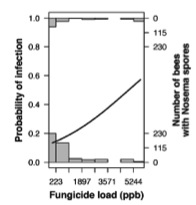The Bee Informed Partnership laboratory at University of Maryland, College Park participated in research to test for the presence of a wide range of pesticides in pollen samples of commercial honeybees. We wanted to know what bees were eating, how many pesticides were present in bee food and at what concentrations, and how pesticide use might correlate to Nosema infection. Nosema is a microsporidian gut-pathogen of honeybees that causes Nosemosis, a bee disease that weakens immune systems and harms colony health. Beekeepers and many in the agricultural community are paying close attention to Nosema due to the recent discovery of a new fungal pathogen, Nosema ceranae, in European honeybees. Research indicates the rapid spread of Nosema ceranae throughout honeybee populations alongside continued infections from long-time nemesis Nosema apis, compounded with affects of infection from an entourage of other new and dangerous pathogens, is playing some role in the honeybee population losses of the last several years.
The report, titled “Crop Pollination Exposes Honeybees to Pesticides Which Alters Their Susceptibility to the Gut Pathogen Nosema ceranae,” was published in an open-access online scientific journal PlusOne (see the report here). Researchers collected pollen pellet samples of commercial bees to find out what they were eating, what types, concentrations, and combinations of pesticides and other chemicals honeybee colonies were exposed to, and colony infection rates of Nosema ceranae. The study found that fungicide levels in particular, were high in both crop and non-crop pollen samples and that some honeybee colonies were exposed to a cocktail of as many as 17 different pesticides (Pettis et al. 2013).


Also, the study found that ‘two fungicides chlorothalonil and pyraclostrobin, and two miticides, amitraz and fluvalinate [emphasis added], increased bees’ susceptibility to Nosema infection’ (Pettis et al. 2013). While not as toxic as many pesticides, these fungicides and miticides can potentially cause lethal or sub-lethal effects on honeybee health at high concentrations (Pettis et al. 2013). Additionally, research indicates the two fungicides listed above decrease honeybee median lethal dose of miticides, making bees more vulnerable to adverse effects from these chemicals. Relative vulnerability to Nosema infection was more than two times higher with chlorothalonil use and almost three times higher with pyraclostrobin.
I recently attended a graduate student level lecture on toxicology of synthetic chemicals that focused on lipid-soluble and persistent compounds. One of the most shocking parts of the lecture was watching a video of school children bathing in DDT in the early 1950’s. Many times, the belief in the safety of modern synthetic chemicals, particularly ones that brought great short-term benefits, made people reluctant to question whether or not their use might come with unintended consequences. We learned about many cases where these chemicals caused sub-lethal effects after bioaccumulation processes in the environment concentrated them above safe levels, especially in animal species such as humans higher up the food chain.
Bioaccumulation occurs with compounds that are (1) persistent in the environment, and (2) lipid-soluble. Bioaccumulative organic compounds often have multiple attached halogens such as chlorine, or fluorine, as well as one or more aromatic groups. The halogens provide stability to the compound preventing degradation, and the aromatic groups make the compound soluble in fat tissues. Animals including bees have toxin-clearing mechanisms that remove toxins from the blood, however lipid-soluble chemicals can become trapped in fat tissue and remain out of reach of these mechanisms. These chemicals can accumulate to higher and higher concentrations over the lifetime of the organism. Accumulated synthetic compounds then can be passed to higher-level predators, like DDT’s bioaccumulation and effects on Bald Eagles, or they can be passed to offspring through fat-rich solutions like breast milk. Concentrations are highest in older adults, but young organisms often experience the most severe effects of toxicity during delicate development processes.
One example of bioaccumulation that really sparked my imagination concerned gastric bypass surgery patients. According to a study presented by our professor, gastric bypass patients sometimes experience complications caused by acute toxicity after surgery. The study found acute toxicity to be the result of rapid metabolism of fat tissues, releasing a lifetime of accumulated fat-soluble chemicals into the blood stream faster than toxin-clearing systems could get rid of them. While the reported effects were sub-lethal, some patients did experience lowered immune system function among other symptoms, with severity depending on how much weight was lost, how fast, and age at time of surgery.
A few questions came to mind: Are pesticides fat-soluble and can they bioaccumulate in fat tissues? Do honeybees have fat? Do honeybees ever experience rapid reduction of fat tissue volume? Are there any points in time honeybees might be more vulnerable to release of bioaccumulating toxins into the blood?
What are some questions that you think of given the examples above?
This post was written by Todd Waters, an undergraduate intern in our lab. Part two of his blog will be posted next week.
References:
CARRECK, N L; ANDREE, M; BRENT, C S; COX-FOSTER, D; DADE, H A; ELLIS, J D; HATJINA, F; VANENGELSDORP, D (2013) Standard methods for Apis mellifera anatomy and dissection. In V Dietemann; J D Ellis; P Neumann (Eds) The COLOSS BEEBOOK, Volume I: standard methods for Apis mellifera research. Journal of Apicultural Research 52(4): http://dx.doi.org/10.3896/IBRA.1.52.4.03
Cruz, Landim C., and Reginato R.D. (1999) Preliminar Report on the Presence of Tegumentar Glands in the Thorax of Meliponinae Bees (Hymenoptera, Apidae). Revista Brasileira de Biologia 59(1): 167-172. Web. 6 Jan 2014.
Pettis JS, Lichtenberg EM, Andree M, Stitzinger J, Rose R, et al. (2013) Crop Pollination Exposes Honey Bees to Pesticides Which Alters Their Susceptibility
to the Gut Pathogen Nosema ceranae. PLoSONE 8(7): e70182. doi:10.1371/journal.pone.0070182. Web. 2 Dec 2013.